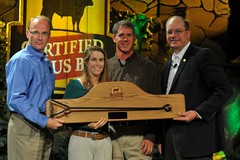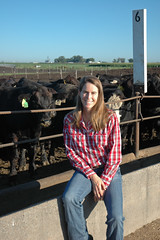Dear Secretary Burwell and Secretary Vilsack,
After researching the science of nutrition and the history of the U.S. Dietary Guidelines, I write to you as a concerned American and a mother of three girls, as well as a cattle rancher. I have great misgivings with respect to the recommendations of the 2015 Dietary Guidelines Advisory Committee.
While raising teenagers is inarguably a challenge, mentoring my own teenage girls through the “sea of dietary confusion” reminds me distinctly of an Iron Man Competition. The CDC reports that 9% of all girls age 12-19 are iron deficient. In particular, athletic girls require more animal protein which uniquely provides heme-iron to ensure good health. Yet, the recommended 2015 Dietary Guidelines reduce even further the recommended dietary intake of animal protein. The “one size fits all nature” of this approach to diet inaccurately provides for the American people, and the resulting dietary education as well as the lunch nutrition that my girls’ receive in the public school system thereby runs contrary to their needs.
The high carbohydrate/low fat diet that serves as the basis for the U.S. Dietary Guidelines stems from epidemiological work begun by Ancel Keys in the 1960’s. Repeatable clinical trial studies since Dr. Keys’ hypothesis was formed have not provided scientific validation to the proposed merits of the diet. A small number of clinical trials done on middle-aged men provide the only non-epidemiological scientific basis for this dietary recommendation. To date, there is virtually no scientific data supporting this hypothesis as healthy for women or children. Perhaps even more disturbing is the culture created in the nutritional community since the establishment of the first Dietary Goals in 1977. Actions include stymieing other diet hypotheses and scientific trial work that do not match the original Key hypothesis. For instance, the 2015 Dietary Guidelines Committee refused to include the BOLD dietary research study in the reference section of their report thereby enabling them to “selectively choose their science” and further cut the recommendation for red meat.
Good science is both debatable and able to be replicated over time. Unfortunately, in addition to a biased approach to nutritional research, the 2015 U.S. Dietary Guidelines Committee Recommendations also include a further reach outside of documented science and into the realm of philosophy relative to the topic of sustainability. The science of sustainability is in its infancy. Much deeper analysis into topics like food waste and appropriate land use need to be completed before substantial information exists to promote one diet over another in the name of sustainability. Additionally, the topic of sustainability is clearly outside the scope of committee responsibilities.
In closing, I request that both of you do what is best for the American public and take a moment to read the research demonstrating that perhaps the high carbohydrate diet is part of the cause of the dietary ailments of Americans rather than the solution. In the lifetime of the Dietary Guidelines the culture of the American diet has shifted dramatically. According to USDA, the consumption of grains (41%), vegetables (23%) and fruits (13%) rose significantly from 1970-2005 while red meat (-22%), milk (-33%) and eggs (-17%) fell dramatically. Overall carbohydrate intake for Americans rose with low fat starches, and vegetable oil took the place of animal protein and fat in the diet. Animal protein lovers shifted from beef to chicken, and many traded whole fat dairy for skim milk and margarine thereby forsaking nutrition density for lower saturated fat options. All of this occurred during a time in the United States when obesity rates more than doubled (15-32%), the prevalence of heart failure, cancer and stroke all increased, and the rate of diabetes increased from less than 1% to 11%. Clearly, the dietary changes caused by dietary guidelines resulted in an “unhealthier America” as Americans traded protein for sugar.
I ask you to help put the science back in nutrition by:
1.Recognizing that the nutrient requirements of Americans vary according to age and sex thereby rendering a one size fits all approach to diet both ineffective and potentially harmful to women and children.
2.Including diverse animal protein options (including beef and whole fat dairy) as part of a balanced and healthy diet.
3.Encouraging a robust and healthy dietary science community where hypotheses are proven before they are sold as truth, and studies on all hypotheses are universally included in the discussion.
4.Removing all verbiage relative to sustainability from the dietary guidelines as that topic is both outside the realm of the committee as well as lacking the necessary scientific basis to be meaningful.
Thank you for your time and consideration.
Sincerely,
Anne Burkholder










Reads well
John Butler Sent from my iPhone
Appreciate it, John. You wrote a good letter as well. Hopefully my posts on this topic will motivate many to send their thoughts to D.C.
Best,
Anne
Nicely written, Anne. I do wish folks would learn to think for themselves, and not blindly accept what our government leaders tell us. I was married in 1967 and have always had butter, eggs, lard, whole milk, and lots of beef (not lean beef either) on my table. I just chose to ignore what our government leaders were telling us.
Thanks for the support, Kathy. Unfortunately, I believe that the problem is growing because further regulation of school lunches and school curriculum leaves our kids inundated with information. It is hard for them to learn to “ignore it”.
We have many dinner table discussions related to “what is a healthy diet”, and what my kids are learning in school is in line with these proposed guidelines rather than what I am trying to teach them. It is frustrating to me as a parent.
As you point out, critical problem solving skills are so very essential. I wish that more emphasis was placed on this and the lack of it makes me worry about the future…
Best,
Anne
You echo my beliefs, I am well beyond the age of school-age children, so I often forget that they are being taught so much that is in direct opposition to their parents’ beliefs, or common sense for that matter. I too worry about the lack of problem solving skills. Please keep up the good work on educating folks.
I agree with almost everything you said even the statement that I am quoting below. “Clearly, the dietary changes caused by dietary guidelines resulted in an “unhealthier America” as Americans traded protein for sugar.” I do however think that you are making the same mistake that followers of Keys have made with this statement. If it were changed to “Clearl, the dietary changes caused by dietary guidelines did not result in a healthier America as Americans traded protein for sugar.”
That is an excellent point— too bad I didn’t have you proof the letter before I submitted it yesterday 🙂
Best,
Anne
Happy to proof any time. Follow us at http://www.giacres.com or on facebook at Adventures in Urban Farming.
Pingback: My Comment Letter To Secretary Burwell and Secretary Vilsack Regarding the 2015 Dietary Guideline Committee Recommendations… | Feed Yard Foodie
Anne,
Great letter, written with conviction, passion and evidence! I use your good stuff all the time
Thanks, Doc. Always good to hear from you — and it pleases me immensely to hear that what I study and write about is meaningful. Thank you for using it with your students. Hopefully together we can make a difference.
Best,
Anne
Wonderful letter. A friend shared a link to it on FB. I plan to share her post for others to read.
Thank you, Jill! I appreciate it. Please spread the word– this is an important topic.
Best,
Anne
Beautiful. I ran xc in high school, I was iron deficient. I would randomly pass out in the halls at school. It stopped when I went to college and started eating more steak to support my track and xc workouts.
Sounds pretty close to my oldest daughter who is currently in high school — boarder line iron deficient, gets dizzy, etc. I try to feed her lots of beef as she certainly needs it to remain healthy. The hard part is that she “learned” in health class that beef (and whole milk) were bad for her…That’s a tough place to put a teenager in — those years are hard enough without getting pulled in opposing directions relative to eating habits.
Glad to hear that you got it figured out. It gives me hope for my XC loving girl 🙂
Best,
Anne
Appreciate the information, good letter and thanks for all your comments.
Thank you, Michael. I appreciate your support and feedback. I hope that you will submit a letter of your own!
Best,
Anne
lets say it right out loud sugar is killing us with diabetes obesity and related to other major diseases. meat is not the problem chemicals in the food supply are not the problem sugar is. White flour and high fructrose corn sugars are right up there with sugar. The science is all there.
I hope that you wrote a comment letter to share your thoughts with Sec. Burwell and Vilsack, Jack! We all need to engage in this conversation — together we can make a difference.
Thanks,
Anne
I’m preparing to teach a Healthy Science unit in my 3rd grade classroom. Coming from a beef raising community, I think I’ll break out the NM Beef classroom materials.
Awesome idea, Kathy! I love it. Keep up the good work 🙂
Best,
Anne
“Overall carbohydrate intake for Americans rose with low fat starches, and vegetable oil took the place of animal protein and fat in the diet. Animal protein lovers shifted from beef to chicken, and many traded whole fat dairy for skim milk and margarine thereby forsaking nutrition density for lower saturated fat options. All of this occurred during a time in the United States when obesity rates more than doubled (15-32%), the prevalence of heart failure, cancer and stroke all increased, and the rate of diabetes increased from less than 1% to 11%. Clearly, the dietary changes caused by dietary guidelines resulted in an “unhealthier America” as Americans traded protein for sugar.”
Well said, Anne. The vegetable/margarine substitution seems to have caused a lot more mischief than most people suppose. Here’s an article by Bill Roberts that delineates the consequences: http://www.doyoueven.com/2015/03/the-fat-that-makes-you-fat/
Interestingly, thanks to biohydrogenation of linoleic acid into stearic acid in the rumen, beef cattle finished on grain do not have a high linoleic acid content. http://jn.nutrition.org/content/early/2011/06/08/jn.111.138396.full.pdf
On the other hand, pork, chicken, and turkey are all too often heavily laced with linoleic acid. https://www.asas.org/membership-services/press-room/press-release-interpretive-summary-archive/saturated-fats-do-not-yield-better-bacon
Pingback: Monkey In the Middle… | Feed Yard Foodie